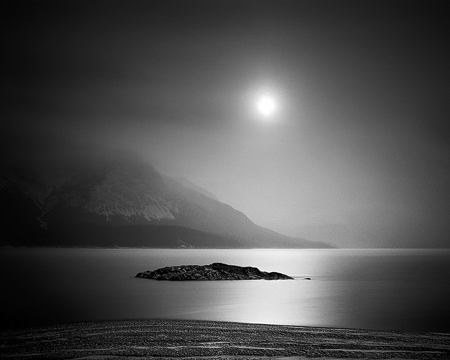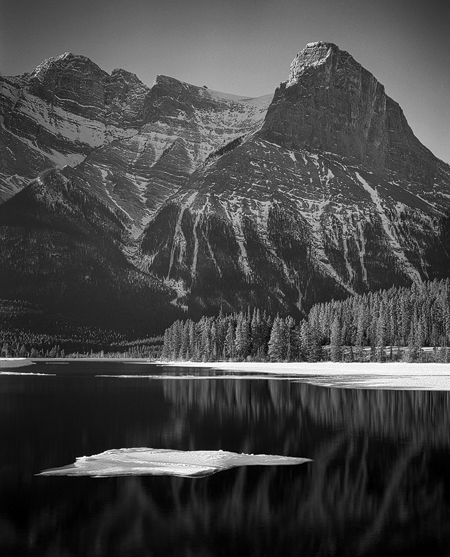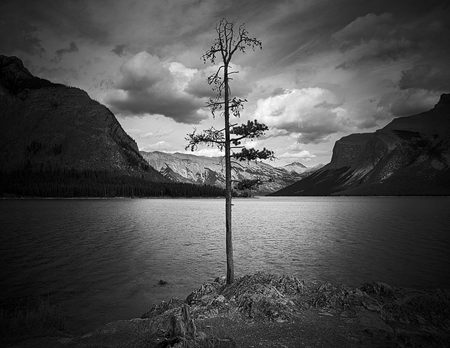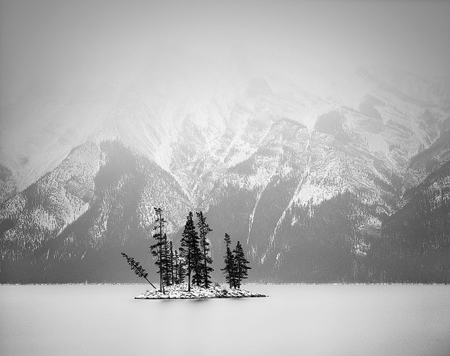#1 Please introduce yourself
My name is Olivier – Oli – Du Tre. I was born and raised in Belgium but since 2009 my wife and I call Cochrane, Alberta home. We actually became Canadian citizens a few weeks ago! I am a traditional fine art landscape photographer who uses a 4×5 camera and develops his black and white sheet film in his kitchen and bathroom.
#2 How did you get interested in photography?
I blame my dad. He was always the one on our family holidays running around with the camera. A shiny Leica M3. He showed me how to focus with a rangefinder, what depth of field was, how to range focus, how to measure light, switch film etc etc. At one point he had set up a little impromptu darkroom in our basement and we did some prints together. That was the coolest thing ever as a kid.
My dad still has that camera, but it’s now collecting dust in a closet back home. Every time he comes over, I ask him for it. One day I will own that camera.
He was the reason why I picked up photography after I graduated in ’98 as a graphic designer.
#3 Do you have an artistic/photographic background?
My grandfather on my father’s side was a painter in his spare time. Their whole house smelled weird (now I know what the smell was, it was the particular smell oil paints have) and the walls were completely covered in paintings. Like, I mean completely covered. Going to my grandparents house as a kid was a daunting experience. The paintings were mostly reproductions by Rubens, Breughel, Rembrandt and Van Dyck my grandfather faithfully copied. Those were not the easiest paintings to understand as a young kid mind you. Sometimes I wish I asked him why he did what he did. And why he wasn’t painting anything original. Looking back, graduating as a graphic designer and afterwards following a 3 year vocational course on black and white photography and archival darkroom printing techniques, was the best thing I could have ever done. I feel it helped me understand the aesthetic qualities of art from different perspectives. Overall I would say I am not ‘artistic’ per se, I am more drawn to the technical side of things.
#4 Which artist/photographer inspired your art?
I have many that inspire me. Both contemporary as old masters. Painters as well as photographers. But Ansel – I know this is a classic answer – is somebody I look up to. His books and his zone system is something I live by. In 2013 I had the chance to see an Ansel Adams exhibit for the first time ever and – to this day – those memories push me to become better at what I do. It was a fabulous experience.
#5 How much preparation do you put into taking a photograph?
It depends. Sometimes I fly by the seat of my pants and photograph whatever catches my eye. Sometimes stuff is more of a concept and I specifically go looking for it. But preparation to make an exposure on a 4×5 camera is always a training for the mind. A setup for exposing 2 sheets can take about 20min. Sometimes – if conditions are windy for example – it can take longer than an hour to make one exposure (due to me waiting for the wind to die down). That whole process is one of the parts that I deeply love. I find great joy in doing everything as precise and consistent as possible.
#6 Which places have been your favourite shooting sites so far and why?
I don’t really believe one should travel to make meaningful art. Most of my work is done very close to home. Usually I photograph in a 50-100km circle around the town I live in. I am fortunate I live in a place where the Alberta foothills, Prairies and Rocky Mountains meet. The subject matter I am attracted to can be literally minutes away in either direction. Cochrane is the perfect place for me I think. I believe that once you develop a relationship with the area you live in, that’s when you start to understand it deeply and you see details you wouldn’t have seen otherwise. That being said, I made a trip to Newfoundland this fall and I found that rather inspiring. I will go back in the near future for sure.
#7 We can see your photographs mostly in black and white, why have you chosen to present them in this form?
Black and white photography is what I do, that’s who I am. In the past I photographed digitally and in colour. Then I switched to only black and white. I finally gave up on the digital stuff and went back full circle to film. Film has qualities in wet print no inkjet can replicate. Plus the smell of fixer is something that got me hooked the first time I smelled it on my hands. What can I say, I am weird. I am in the process of building a new darkroom in my basement. When that is completed (hopefully late winter) I will start wet printing again. Over the past few years I slowly got rid of everything in my workflow that runs on electricity. The only thing I am keeping is my spot meter. To me printing in Black and White is something that comes naturally. I can express in Black and White a lot better than I could in colour. To me really it is timeless art. We can look at a print made decades ago and think it was made yesterday. The same hopefully will hold true for my work.
#8 Could you please tell us something about your technique and creating process?
I am a wanderer and wonderer. Most of the time I aimlessly drive around, hoping to bump into something extraordinary. When I am attracted to something I usually know right away. It stops me dead in my tracks. The composition and final photograph are in my mind. But instead of just making that photography and drive onward, I start to study the scene a bit closer and ask the question why. Why did I stop? Why is it I am drawn to this. When I can answer those questions, that’s when I start to think about the real composition. As so many large format photographers I carry a composition card with me. I make pictures in my head and study compositions through the window of the card. Photographers I’ve met find this a futile exercise. I find it rather the opposite. Only when I am satisfied with the result I am seeing in the window, that’s when I will set up my 4×5 camera – a Shen Hao with 3 Fujinon lenses (90, 180, 250) to mimic what I saw in the window on the ground-glass. Once that is done I need to decided on movements, exposure and filtration. For film I mainly use Ilford Delta 100 film in combination with 1+4 Ilford Ilfotec DD-x. And of course I use the zone system for every exposure I make.
Development afterwards happens in my kitchen 6 sheets at a time, by hand, in a 3 reel Paterson tank. Once the final wash is completed I hang these negatives to dry in a spare bathroom. Once those are completely dry (next day or so) I put them on the light table and inspect them for sharpness and put them in sleeves.
For now I scan my negs on a V600. It’s kind of a hackjob because it doesn’t scan 4×5 negs. I am not spending the money on a new scanner because of the darkroom plans I have. But every time I use the scanner, it’s a stimulation to get the darkroom done. It’s that annoying! It is a pain, but it works for now. If I need to output big, I ask a friend to drumscan my negatives on his Howtek scanner.
In Photoshop, I use a very simple technique of dodging and burning, something that resembles bleaching and simple contrast adjustments. Then I output through K3 Epson printers with a dedicated black and white rip on Canson Platine Fibre Rag. Once the print is QC inspected and approved, they then get a stamp and signature on the back of the print.
#9 What do you do in your life besides photography?
Between 9 and 5 I work as graphic designer for one of Canada’s top agencies. All other hours of the day I’d like to think I am a photographer.
#10 What future plans do you have? What projects would you like to accomplish?
I love teaching photography. And this year and next year will be quite busy. I see teaching as a great way of improving one’s photography. It makes you think about what you do yourself. I’ve also dreamt of publishing a book (or a few books) sometime down the road.
Olivier Du Tre portfolio:
www.olivierdutre.com









One Response to “Olivier Du Tre”
Gary Nylander
Very good interview well spoken!